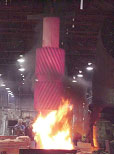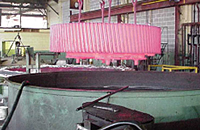Carburizing
(click on thumbnail to enlarge)
| 1.) 19,000 Pound double helical pinion shaft carburized to an effective case depth of 0.250" being quenched into 20,000 gallons of agitated, warm oil. Pinion was heat treated vertically one of two Metlab 54" diameter by 180" deep pit furnaces. It was control heated to 1750°F, held at temperature for almost 200 hours, then slow cooled, reheated to the hardening temperature, quenched, tempered, deep frozen and retempered. |

Carburizing |
| |
| 2.) 26,000 pounds of low carbon steel flat wire being prepared for spheroidize annealing. Spheroidize annealing is an intermediate processing step to allow the wire to be further rolled to a smaller gage without cracking. |

Carburizing |
Carburizing | Facilities

Carburizing
Carburizing, also referred to as Case Hardening, is a heat treatment process that produces a surface which is resistant to wear, while maintaining toughness and strength of the core. This treatment is applied to low carbon steel parts after machining, as well as high alloy steel bearings, gears, and other components.
Carburizing increases strength and wear resistance by diffusing carbon into the surface of the steel creating a case while retaining a substantially lesser hardness in the core. This treatment is applied to low carbon steels after machining.
Strong and very hard-surface parts of intricate and complex shapes can be made of relatively lower cost materials that are readily machined or formed prior to heat treatment.
Most carburizing is done by heating components in either a pit furnace, or sealed atmosphere furnace, and introducing carburizing gases at temperature. Gas carburizing allows for accurate control of both the process temperature and carburizing atmosphere (carbon potential). Carburizing is a time/temperature process; the carburizing atmosphere is introduced into the furnace for the required time to ensure the correct depth of case. The carbon potential of the gas can be lowered to permit diffusion, avoiding excess carbon in the surface layer.
After carburizing, the work is either slow cooled for later quench hardening, or quenched directly into oil. Quench selection is made to achieve the optimum properties with acceptable levels of dimensional change. Hot oil quenching may be used for minimal distortion, but may be limited in application by the strength requirements for the product. Alternatively, bearing races may be press quenched to maintain their dimensional tolerances, minimizing the need for excessive post heat treatment grinding. In some cases, product is tempered, then cryogenically processed to convert retained austenite to martensite, and then retempered.
Metlab has the ability to carburize and harden gears and other components that are small enough to be held in one's hand, up to 14' in diameter and 16' tall, weighing as much as 50,000 pounds. Shallow cases only 0.002 - 0.005", and deep cases, up to 0.350" have been specified and readily achieved.
The press quench located in the facility allows for the dimensional control, therefore precise hardening of gears and bearings up to 16" in diameter.
Facilities
Gas Carburizing/Carbonitriding (1500° - 1850°F)
Maximum Load Sizes
- Pit Furnace - 180" Diameter by 144" High
- Pit Furnace - 144" Diameter by 96" High
- Pit Furnace - 36" Diameter by 60" High
- Pit Furnace (2) - 54" Diameter by 180" High
- Bell Furnaces (4) - 72" Diameter by 84" High
|
- Integral Oil Quench Furnaces - 24" x 36" x 24" High, 18" x 24" x 18" High
- Car Bottom - 78" Wide by 78" High by 192" Long
- Rotary Hearth Furnace and Press Quench - Up to 16" Diameter Parts
|

back to top |






 Print This Page
Print This Page


